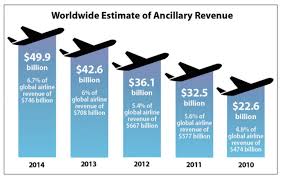What is Ancillary Revenue: How Airlines Can Boost Ancillary Revenues?
Ancillary revenue, ancillary sales, and ancillary income all refer to additional income generated by a company from sources other than its primary products or services or through the sale of goods or services that are not its main source of revenue or core business focus. Examples include concessions sales in a sporting arena or restaurant and spa services in a hotel.
What is Ancillary Revenue?
Ancillary revenue is a common aspect of businesses across various industries, with only very small or new companies being potential exceptions. Typically, it serves to support or enhance revenue derived from the sales of a company’s primary products or services. However, there are cases where Ancillary may outperform the earnings from the main offerings, highlighting its significance as a revenue stream.

Ancillary Revenue Meaning:
Ancillary revenue definition is it refers to the additional income generated by a company or organization beyond its primary sources of revenue. Examples of Ancillary sources include fees for extra luggage, in-flight meals, seat upgrades, hotel amenities, and other similar offerings.
Ancillary income definition typically includes revenue generated from secondary or supplementary products, services, or activities that complement the main offering.
Ancillary sales specifically refer to the sales of goods and services that are not the company’s main product or service offering. These sales typically involve add-ons, upgrades, or supplementary products that accompany the core offerings.
Ancillary income is a broader term that encompasses any additional income generated by a company beyond its primary sources. It can include revenue from ancillary sales as well as other sources such as rentals, licensing, commissions, and partnerships.
Airline Ancillary Revenue.
Ancillary in the airline industry refers to the income generated by airlines through the sale of services and goods that go beyond their primary product offering. It plays a crucial role in ensuring financial stability and enhancing the overall travel experience for passengers.
Ancillary revenue ideas for airlines involve generating income from sources other than ticket sales. It serves as a vital component of an airline’s total revenue and can help offset operational expenses, such as Baggage fees, In-flight services, Seat selection, Entertainment, Wi-Fi, Loyalty programs, and frequent flyer memberships. Ancillary airlines are revenue generation sources that differ from ticketing revenue.
In today’s fiercely competitive airline industry, airlines are increasingly turning to ancillary revenue as a strategic tool to bolster their financial stability and offer enhanced services to passengers. Ancillary has emerged as a game-changer, enabling airlines to diversify their income streams beyond traditional ticket sales. Let’s delve into the world of airline ancillary and explore its significance in transforming the travel experience.
1. Definition and Scope:
Ancillary revenue in the airline industry refers to the additional income generated by airlines through the sale of non-ticket products and services. These offerings go beyond the core flight experience and provide passengers with optional extras, upgrades, or personalized services that enhance their journey.
2. Enhancing the Travel Experience:
Ancillary allows airlines to offer a range of services that cater to diverse passenger needs and preferences. This includes options such as seat upgrades, extra legroom, in-flight Wi-Fi, premium meals, baggage allowances, and priority boarding. By providing these ancillary services, airlines can tailor the travel experience to individual passengers, promoting comfort, convenience, and personalization.
3. Ancillary Revenue Streams and Innovation:
Ancillary opens up new revenue streams for airlines, reducing their reliance solely on ticket sales. By leveraging partnerships and collaborations, airlines can expand their offerings to include hotel bookings, car rentals, travel insurance, and destination experiences. Additionally, airlines can monetize advertising opportunities, and loyalty programs, and even sell branded merchandise, creating additional revenue sources.
4. Offsetting Operational Costs:
Ancillary revenue plays a crucial role in offsetting operational costs, such as fuel expenses and maintenance. By generating additional income, airlines can invest in improving their services, infrastructure, and fleet, ultimately benefiting passengers through enhanced safety, comfort, and efficiency.
5. Challenges and Opportunities:
Implementing a successful ancillary revenue strategy requires careful planning, market research, and effective communication with passengers. Striking a balance between offering valuable ancillary services and avoiding a perception of excessive fees is crucial. Airlines must also adapt to evolving customer demands and technological advancements to seize new opportunities for revenue generation.
- Baggage fees
- On-board retail
- Premium seat selection
- Food and beverage sales during flights
- Early screening and boarding
- In-flight pay-per-view movies
- Headphones for in-flight movies
- Special meal packages
According to IdeaWorks Company, ancillary revenue in the airline industry can be derived directly from passengers or indirectly through the overall travel experience or third-party engagement. In 2022, global revenues reached over USD 102 billion, a significant increase from USD 42.6 billion in 20XX.
How Does Ancillary Revenue Help Companies?

Ancillary revenue helps companies diversify their income sources beyond their core offerings. It’s the revenue that comes from offerings beyond the core products or services. For instance:
- Airlines earn ancillary revenue through baggage fees, seat selection charges, and in-flight sales.
- Hotels generate it from restaurant services.
- Gas stations may offer car wash services as an ancillary source of income.
- Apple Inc., known for its iPhones, has diversified its earnings by creating revenue streams, such as accessories and services.
Irrespective of the industry or sector, it is common for companies to generate revenue. If this additional revenue exceeds the earnings from the company’s previous primary sources, it may necessitate a shift in the company’s business model to ensure its continued success and prosperity.
How Can Businesses Maximize Their Ancillary Revenue?
Here are some strategies businesses can use to maximize their ancillary revenue:
1. Review Your Product Range:
-
- Identify products or services that would appeal to your existing customers or help them make better use of your core products.
- Consider professional services that add value, such as training or maintenance services.
2. Offer Upsell Opportunities:
-
- Promote ancillary products or services that improve the customer experience.
- For airlines, this could mean offering extra legroom, priority boarding, or in-flight amenities.
3. Charge for Additional Services:
-
- Consider charging customers for premium services or add-ons.
- Examples include baggage fees, seat selection charges, or expedited shipping.
4. Improve Convenience:
-
- Offer ancillary products or services that enhance convenience.
- Think about services like express check-in, concierge assistance, or home delivery options.
5. Promote Ancillary Services:
-
- Train sales representatives and staff to upsell ancillary products.
- Explain how these offerings enhance the overall customer experience or add value.
Remember, ancillary revenue can significantly boost a company’s overall income when strategically implemented! 📈💡.
How Airlines Can Boost Ancillary Revenues?

Ancillary revenues are on the rise, and airlines are becoming increasingly reliant on them. To further boost ancillary sales, companies are focusing on empowering frontline employees to effectively collect fees and charges. Taking a holistic approach is key to achieving significant growth in ancillary sales.
To enhance ancillary sales and support frontline employees in collecting fees effectively, airlines should consider the following strategies:
- Fostering understanding and commitment: Ensure that frontline employees understand the transparency of ancillary fees and how customers are informed about them during the booking process, confirmation emails, and through signage.
- Providing appropriate tools and support for success: Identify the specific tools and resources that frontline employees require by addressing pain points in ancillary sales processes.
- Aligning processes and structures: Establish processes and structures that motivate and support frontline workers, enabling them to prioritize and focus on ancillary revenue generation.
- Enhancing talent and skills: Implement frequent training programs for check-in agents, covering processes, policies, and specific encounters related to ancillary sales. This training should include role-playing exercises, scripts for effective communication, and frameworks for handling conflicts.
To boost ancillary revenue, companies can consider diversifying product lines, adding additional services, outsourcing when necessary, charging for services, and providing maintenance services. Ancillary revenue offers benefits such as increased market reputation and income diversification. However, it also has drawbacks, including the need for transparency and customer skepticism. To maintain sustainable development and investor trust, firms must carefully balance their ancillary revenue streams with their primary sources of income.
Ancillary revenue is a valuable tool for companies to generate additional income, enhance their market position, and create value for shareholders and customers alike. Ancillary revenue offers several benefits and opportunities:
- Income diversification: Ancillary revenue provides an additional source of income beyond the primary revenue stream, contributing to overall financial stability.
- Waste utilization: Materials considered waste by one company may hold value for another, creating opportunities for generating revenue through their sale or repurposing.
- Employment generation: The expansion of ancillary services can create new job opportunities, contributing to increased employment levels in the economy.
- Market reputation enhancement: By providing ancillary services, a company can enhance its market reputation, improving customer perception and loyalty.
- Shareholder wealth creation: Ancillary revenue can positively impact financial statements, leading to improved shareholder value and wealth creation.
- Justification for higher prices: Ancillary services can justify higher prices for products or services, as customers may be willing to pay more for the added value and convenience they offer.
Disadvantages:
- Customer skepticism: Customers may be suspicious of the prices charged for ancillary services, which could lead to a loss of sales if they perceive the prices as unfair or excessive.
- Volatility of demand: Ancillary services are optional, and customers may choose not to avail themselves of them. As a result, ancillary revenue cannot be guaranteed and should be treated as an addition to the primary revenue source.
Read More:





